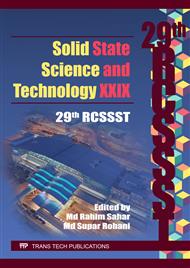p.210
p.219
p.224
p.229
p.234
p.239
p.244
p.249
p.254
Growth of Copper Nanowires by Using Thermal Oxidation for Solid Oxide Fuel Cell
Abstract:
Tuning high density nanostructures by simple and economic method may contribute towards the development of solid oxide fuel cells. Copper oxide nanowires grown on Cu foil by thermal oxidation at relative low operating temperature from 400°C are characterized by using x-ray diffraction (XRD), energy dispersive x-ray spectroscopy (EDX), atomic force morphology (AFM), conductive-AFM (C-AFM), and field emission scanning electron microscopy (FESEM). The role of oxidizing temperature and time on structural and electrical properties are studied. The formation of nanowires is confirmed by X-Ray diffraction pattern with the presence of copper oxide. The electrical conductivity of the nanowires was ranging from 0.2x105 S m-1 to 0.8x105 S m-1are determined from conductive atomic force microscopy. The oxidation time strongly influence the morphology and chemical composition of the nanowires. Field emission scanning electron microscopy reveals the growth mechanism of copper nanowires formation is based on vapour-solid (VS) mechanism. Herein, the successfully growth of CuO nanowire are directly from Cu foil to overcome the mismatching stress between the substrate and the oxide layer. Optimum parameters are studied to make better electrolyte performance in the applications of solid oxide fuel cell (SOFC).
Info:
Periodical:
Pages:
234-238
Citation:
Online since:
October 2017
Authors:
Price:
Сopyright:
© 2017 Trans Tech Publications Ltd. All Rights Reserved
Share:
Citation:


